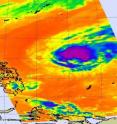Tropical storm Omais weakens and doubles in size
Tropical storm Omais has run into wind shear in the northwestern Pacific Ocean, but as it has weakened overnight it has also doubled in size. NASA's Aqua satellite has captured both infrared and visible images early this morning of the larger Omais. Late yesterday, March 24, Omais strengthened to (63 mph) 55 knots and now that it has run into an environment with stronger wind shear, it has already weakened. The wind shear has increased because of the approach of a frontal system which is currently about 215 nautical miles northwest of the storm.
This morning at 0900 UTC (5 a.m. EDT) Omais' maximum sustained winds were down to 52 mph (45 knots). Omais, known in the Philippines as "Agaton," is now about 515 miles north-northwest of Palau, Micronesia, near 15.3 North and 131.5 East. It's a slow moving storm, creeping along at 5 mph (4 knots) in a north-northwesterly direction.
As the storm continues to weaken, the reach of its tropical storm-force winds is expanding over a larger area. On March 24, tropical storm-force winds of 39 mph extended 30 miles out from the center. Now that Omais has weakened winds of that same strength extend as far as 65 miles from the center, so the area of tropical storm-force winds has more than doubled overnight.
The Atmospheric Infrared Sounder (AIRS) instrument on NASA's Aqua satellite captured cold thunderstorm cloud tops in the center and southwestern corner of Tropical Storm Omais on March 25 at 12:41 a.m. EDT. The cluster of high thunderstorms on the southwestern edge is easily seen in today's AIRS visible image, as are the clouds associated with the cold front to the northwest of Omais.
As the cold front approaches, cooler and drier air associated with it will prevent cloud formation (and thunderstorm development), and vertical wind shear will increase. As a result, Omais is expected to dissipate over the next day and a half.
Source: NASA/Goddard Space Flight Center
Articles on the same topic
- Winds blow off Omais' thunderstorm tops15 years ago
- Imani on the weakening on weekend15 years ago
- Imani reaches cyclone status 'by the tail'15 years ago
- 02W renamed Tropical Storm Omais, staying at sea15 years ago
- Tropical Storm Imani making a question mark in the Southern Indian Ocean15 years ago
- NASA's Aqua Satellite sees a tight Tropical Storm 21S15 years ago
- Tropical Depression 02W forms in northwestern Pacific15 years ago
Other sources
- Imani on the weakening on weekendfrom Science Blog15 years ago
- Winds blow off Omais' thunderstorm topsfrom Science Blog15 years ago
- Imani on the weakening on weekendfrom Physorg15 years ago
- Winds blow off Omais' thunderstorm topsfrom Physorg15 years ago
- Imani on the weakening on weekendfrom Science Blog15 years ago
- Winds blow off Omais' thunderstorm topsfrom Science Blog15 years ago
- Tropical storm Omais weakens and doubles in sizefrom Science Blog15 years ago
- Imani reaches cyclone status 'by the tail'from Science Blog15 years ago
- Imani reaches cyclone status 'by the tail'from Physorg15 years ago
- Tropical storm Omais weakens and doubles in sizefrom Physorg15 years ago
- 02W renamed Tropical Storm Omais, staying at seafrom Physorg15 years ago
- Tropical Storm Imani making a question mark in the Southern Indian Oceanfrom Physorg15 years ago
- Tropical Storm Imani making a question mark in the Southern Indian Oceanfrom Science Blog15 years ago
- 02W renamed Tropical Storm Omais, staying at seafrom Science Blog15 years ago
- NASA's Aqua Satellite sees a tight Tropical Storm 21Sfrom Science Blog15 years ago
- NASA's Aqua Satellite sees a tight Tropical Storm 21Sfrom Physorg15 years ago
- Tropical Depression 02W forms in northwestern Pacificfrom Science Blog15 years ago
- Tropical Depression 02W forms in northwestern Pacificfrom Physorg15 years ago
- Tropical Depression 02W forms in northwestern Pacificfrom Science Blog15 years ago



